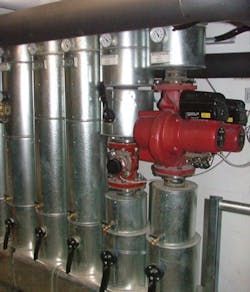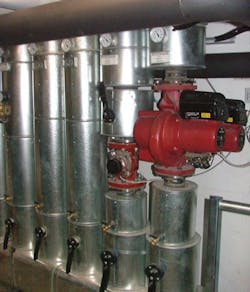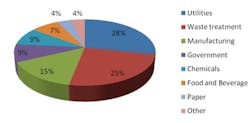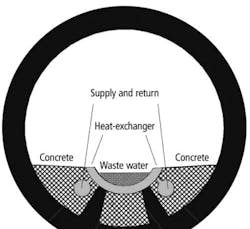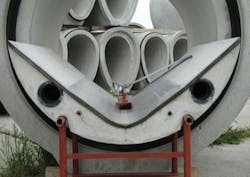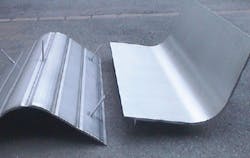Pipe Dream or Profitable Reality? Recovering Heat from Wastewater
Sewer rehabilitation will be a key theme of this year's IFAT Entsorga show. And with German municipalities predicted to invest an average of 8000 euros per year for each kilometre of wastewater network, it's easy to see why. In this article the Institute for Underground Infrastructure advises on the technical and economical feasibility of heat exchangers in wastewater channels.
The recovery of heat from wastewater can become a profitable activity for network operators. Depending on the season, wastewater generally features a temperature level between 10 and 20°C. This heat energy can be recovered by means of wastewater heat recovery systems (WHRSs) and can be used for heating real estate as well as for hot water supply. Components of a WHRS are heat exchangers, transmission lines and a heat pump.
The recovery of heat from wastewater takes place in three heat exchange processes. In the heat exchangers above which the wastewater flows, a medium circulates thereby adapting to the temperature of wastewater. The heated medium is fed to a heat pump through transmission lines. There, a second heat exchange takes place through a medium inside the heat pump. This evaporates as a result of the heat supply from the channel. In the heat pump, compression of the evaporated medium occurs now by means of which the temperature is raised to a useful level. In a third heat exchange, the heat is fed into the heating circuit.
A peculiarity of heat recovery from wastewater exists in that this is a component of a hybrid heating system: the heat pump supplies the base load demand; a conventional boiler is used additionally for peak load demand. A further peculiarity lies in the possibility of using WHRSs for the air-conditioning of rooms. In that case, the heat exchange operates in the reverse direction, i.e. surplus room heat is transferred to wastewater.
Influence of heat exchangers on the sewer system
IKT examined the "Heat recovery from sewer systems" within the scope of the research project and the influence of heat exchangers on the sewer. Researchers oriented themselves towards the heat exchangers and the Rabtherm® system installed in Leverkusen, Germany. These heat exchangers consisted of non-rusting stainless steel are incorporated in a dry-weather sewer and have direct contact with wastewater.
Investigations yielded that negative effects on leakage tightness or durability are hardly expected, just as restrictions of durability through corrosion be expected. Also sewer cleanings allow no changes to be expected, which have a negative influence on the durability of heat exchanger elements.
Conditions for reasonable use of WHRSs were mapped out and then documented in a requirement catalogue. It has become evident that for reasonable utilisation of wastewater heat, notable technical and economic restrictions must be observed. Technical requirements are based on features of the sewer system. If the following criteria is filled then suitable sewer system sections can identified for heat recovery:
• Minimum cross-section> DN 800 (accessible channel)
• Middle dry-weather drainage> 12 to 15 l/s
• Minimum gradient
• Material and condition of the channel
• No restrictions of the required hydraulic reserves
• Channels that are as straight as possible, with a length of up to 200 m
• Accessibility for building phase and operation
• Exclusion of falling short of the minimum operating temperature for waste-water treatment systems.
Based on the size of networks, sewer system sections can be found which fulfil technical restrictions and are thus fundamentally available for the heat recovery from wastewater.
Marketing of heat from wastewater
Beyond the recovery, the marketing of the heat energy plays a central role. Therefore, also economic restrictions for the use of WHRSs are to be observed. Suitable locations for the marketing of heat from WHRSs are characterised in that:
• At a maximum distance of 200m from the place of heat recovery a heat consumption demand of minimum 150 kW can be served
• The WHRS is possibly continuously used at full capacity (sale of heat energy in winter and air-conditioning energy in summer)
• The timeline for investments in new channel construction or restoration, energy supply and heating system coincide.
If these prerequisites are fulfilled, the economic advantages of a WHRS can come to effect. However, a further step is required for the realisation of a WHRS: the involved participants must undergo a voluntary and durable cooperative relationship. Involved participants are channel network operators and energy providers on the supply side and real estate owners on the demand side. Within this group, cooperation can work if all expense (investment and overhead) can be covered and furthermore a profit can be collect from the yields of marketing the heat energy. In that case, heat energy must be offered at competitive prices so that heat from wastewater also becomes interesting for the demand side.
Profitability is the economic key criterion in the marketing of wastewater heat. A profitable WHRS exists if heat energy is offered at competitive prices and from the proceeds all occurring investment and overhead as well as the profit claims of the supplier (channel network operator, energy provider) are served.
Potential of heat recovery from wastewater in North Rhine Westphalia (NRW)
With the help of heat exchangers around 1.5 kWh per temperature difference can be recovered from 1,000 litres of wastewater. The output capacity per metre of heat exchanger is about 2.5 kW. Thus, a system with a maximum of 200 m long heat exchanger features output capacity of approximately 500 kW.
While considering technical and economic restrictions, the IKT has the roughly calculated the potential for the recovery and marketing of heat from wastewater for the State of NRW. An annual potential exists for about 50 WHRSs with an entire output capacity of 25 megawatts within the approximately 87,000 km of long sewer system in North Rhine Westphalia.
Moreover, an increased competitiveness of WHRS is to be expected with the increase of crude oil prices because in WHRSs primary energy is required only to comparatively small scope. In the end, also learning effects can find positive expression in the economics during erection and operation of WHRSs.
Challenges to harnessing wastewater heat
In order to be able to use heat from wastewater, first of all a careful selection of suitable locations must occur based on the criteria illustrated above. For the selected locations, the profitability to be expected must be determined based on economic calculations in an individual case. In case of a positive result, the basic prerequisites are fulfilled for the cooperation of involved participants.
Suitable locations are fundamentally available, however, they are not known to neither the channel network operators nor to the energy providers. Moreover, information asymmetries exist indicating that energy providers know little about the wastewater and energy quantities at disposal in the sewer system. Also, it is not well known to the energy providers when channel sections are restored and where the channel sections are, which generally fulfil the technical prerequisites for the heat recovery from wastewater.
For wastewater heat source to be developed and harnessed systematically, then the information asymmetries must be dismantled. This can occur in the following idealised steps:
- • The network operators disclose those locations for which the technical requirements are fulfilled for the heat recovery from wastewater
- • The energy providers undertake an assessment of the locations with regard to the marketing chances
- • For potentially suitable locations, an economic viability calculation is performed
- • Channel network operators and energy providers agree on a binding regulation about the distribution of the profit as well as of the tasks and obligations for the erection and operation of the WHRSs.
Benefits for channel network operators
The recovery of heat from wastewater can be advantageous for channel network operators because revenue is earned from the provision of the sewer system for the heat recovery. In that case, at minimum, the costs incurred by using wastewater heat must be compensated including the additional overheads (for example, increased inspection and cleaning expenses).
In order to give network operators an incentive for commitment to the heat recovery from wastewater, they must additionally participate in the profits from marketed waste-water heat. As far as the financial freedom of action for mastering of the draining task can be improved in this manner, indirect benefit also emerges for to the benefit of the water conservation.
A further interesting aspect exists: the sewer network system is seen as an energy supply system beyond the function of wastewater disposal, which is not often perceived by the public. If the services around the sewer system come into the consciousness of citizens more strongly through the heat recovery from wastewater, then advertisements for positive attitude to the activities by channel network operators can be made in this manner.
Good relations between channel network operators and citizens can pay off at some point in time if channel network operators must approach the citizens with less popular tasks, for example, with regard to the drainage of real estate.
Author's note: The Institute for Underground Infrastructure (IKT) is an independent, non-profit research, testing and consulting institute based in Germany. It works on the construction of underground pipes and networks for gas. For more information, please email: [email protected]
More Water & WasteWater International Current Issue Articles
More Water & WasteWater International Archives Issue Articles
